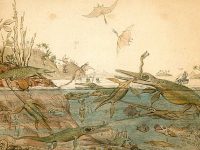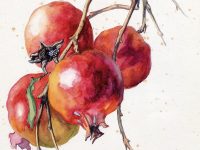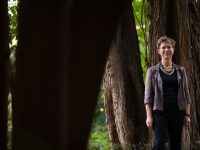The mystery of movement in plants
Darwin and the circumnutation of climbing plants
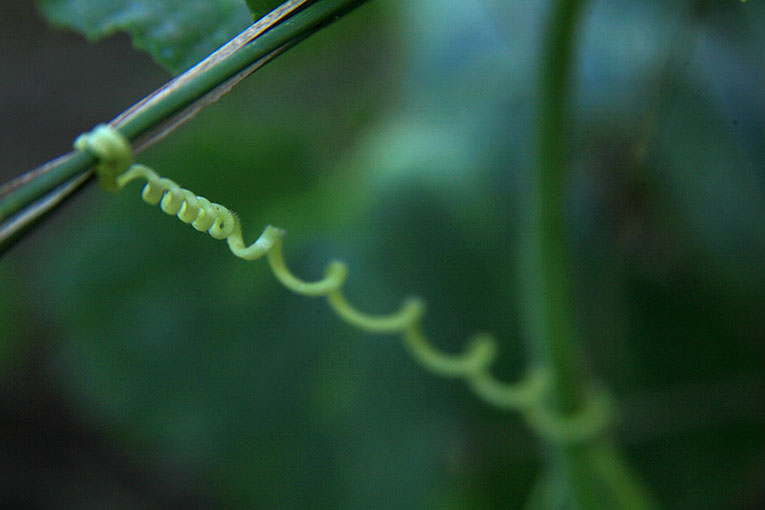
Plants are able to bow and bend, a movement known as circumnutation, by means of which they can wind around a central axis during growth. This ability is more highly developed in climbing plants, whose different organs –stems, branches, flower peduncules, petioles, central nerves of the leaves and adventitious roots– have the power to move, giving them access to the optimal environmental conditions in which to develop. Charles R. Darwin carried out the first systematized study on the movement of climbing plants and proposed brilliant evolutionary hypotheses to explain their origin and the perfection of the ways in which climbing mechanisms are supported. Thanks to molecular analysis we have now begun to understand the genetic bases of circumnutation movement.
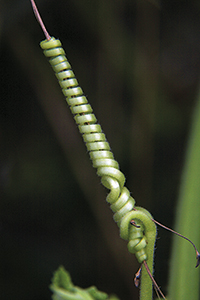
It is common to speak of plants as sessile organisms which, unlike animals, cannot change locations to get water or food or to escape predators and stressful environmental conditions. However, the ability to execute certain movements is a characteristic of plants that allows them to carry out functions such as the absorption of water and nutrients and to optimize their exposure to light. These movements include tropisms or growth directed towards external stimulus – such as phototropism or light-oriented growth as well as geotropism or gravity-oriented growth, – the nastic movements whose direction depends on the morphology of the movable member, as is the case of some carnivorous plants that snap shut when an insect touches them, or of the nocturnal movements of the leaves of some plants, such as legumes, caused by changes in the turgor of specialized cells subject to circadian rhythm.
In addition, the organs of plants have the ability to perform an oscillatory motion describing a spiral called circumnutation. With the ability to wind around a central axis during growth, plants can reach places with more favourable environmental conditions, such as, for example, those that have better exposure to light. The amplitude, period and form of circumnutation depend on the plant species and stage of development, although vines – plants with a herbaceous or woody texture with an elongate flexible stem able to climb or crawl on a support – show a marked circumnutation capacity. Climbing plants are able to cling to various supports by simply twining around a stake, as in the case of the Japanese morning glory (Ipomoea nil), or by using hooks, like Galium aparine, also known as cleavers, or by tendrils, as is the case of some legumes such as peas (Pisum sativum), or using the petioles of the leaves (Clematis glandulosa) or adventitious roots, as does the ivy, Hedera helix.
Darwin’s interest in the morphology of climbing plants
2009 marks the two hundredth anniversary of the birth of Charles R. Darwin (1809-1882). I have always been struck by the insistence to celebrate anniversaries of major events that happened twenty-five, fifty, a hundred or many hundred years ago. As if the decimal system kept some special relationship with the course of things and our lives. Personally, and referring to a more or less recent past, I prefer to think in terms of human generations to which, if recent, we can assign an average span of twenty-five to thirty years. So in 2009 we are preparing to celebrate Darwin’s birth, which happened about seven generations ago, six for my father and five for my grandfather.
Charles Robert Darwin tried to find an explanation for biological diversity and concluded that all species are related to each other, as ancestors or descendants. Seven generations of humans after Darwin, a developmental biologist would say there is a great unity of design among the millions of species. The genetic design is very similar and so many genes are interchangeable between organisms as shown by GMO experiments.
«The ability to execute certain movements is a characteristic of plants that allows them to carry out functions such as the absorption of water and nutrients and to optimize their exposure to light»
Darwin published On The Origin of Species in 1859, when he was fifty years old. The basic principles of the evolution of living beings through natural selection that would occur as a result of the struggle for life provided an explanation for the high biodiversity. Once these principles were established during a reflection that took him longer than 20 years, Darwin engaged in frenetic activity to organize his observations and to make new ones placed in a general framework in which the temporal sequence of changing forms would be linked to the balance between extinction and appearance of new species. It is in this context that Darwin made the first systematized observations about the forms of climbing plants and their implications for the movement of plants.
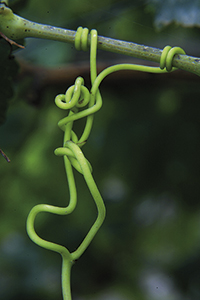
The hot-houses with plants in Darwin’s Down House were built in early 1862. Over the next three years, when his health was poor, Darwin was able to observe movements of nutation in climbing plants, both in his hot-houses as in his study. He published his findings in 1865 –just six years after the publication of On The Origin of Species – under the title «The Movements and Habits of Climbing Plants» in the Journal of the Proceedings of the Linnean Society of London, vol. 9, pages 1-128, which included thirteen engravings illustrating the text. This work offers a wonderful view of Darwin as an experimentalist, making observations on a variety of plant species, being careful not to modify his subjects by the methods of observation and performing careful measurements. At one point, Darwin describes how «the plant tried in vain to twine around a post of 5 inches in diameter, whereas it managed to twine around another of 3.6 inches.» It’s easy to imagine Darwin in his hot-house writing down these measures in his notebook with the help of a simple caliper.
Darwin treated living beings as adaptive organisms whose morphological structures would contribute to their survival. In fact, Darwin has been criticized for being too teleological in his approaches, but teleological explanations can actually be useful if used with caution and they stimulate creative research. For Darwin, living creatures would perform actions aimed at achieving goals and with this thought it was easier to speculate about the physical and biological laws involved. Starting from a teleological position and searching later for mechanistic explanations provided Darwin with a suitable method for describing forms, functions, causes and effects.
Charles Darwin remained interested in the study of the movement of plants after his first publication on the movements of climbing plants in 1865. In fact, he co-authored a book with his son Francis in 1880, when he was 71 years old and just two years before his death, entitled The Power of Movement in Plants, where they exposed that the same mechanisms proposed to explain the movements of nutation of climbing plants were valid for angiosperms in general.
Types of climbing plants according to Darwin: evolutionary implications
According to Darwin’s work method, from the teleological to the mechanistic, we can assume that plants become climbers in order to reach the light and to expose a large surface of their leaves to its action and to that of the free air. Climbers achieve this with little expenditure of organized matter, in comparison with trees, whose massive trunks have to support a load of heavy branches. This minimum expenditure explains the existence of so many climbing plants belonging to so many different orders, in all corners of the world. We can, with Darwin, classify these plants into four classes, excluding those that merely scramble over bushes without the aid of specialized organs. Thus, we distinguish between hook-climbers, which are the least effective of all, at least in temperate places, and which can only climb in the midst of an entangled mass of vegetation; root-climbers that are excellently adapted to climb the naked faces of rocks or the trunks of trees – but when they climb trunks they are required to stay in the shade so they cannot pass from one branch to the other and hence cover the entire summit of the tree because their rootlets, to adhere, require close and continuous contact with a steady surface –; twiners able to wind around a support or stake, and those with sensitive organs, namely, leaf-climbers and tendril-bearers.
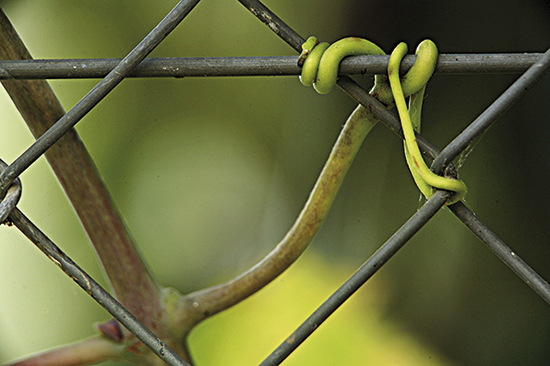
Taken together, the twiners and plants with sensitive organs are more numerous and have more sophisticated climbing mechanisms than the two first classes. In fact, climbing plants which have the ability to revolve spontaneously and grasp objects with which they came into contact can pass easily from one branch to another and secure a wide, sun-lit surface.
The types of climbing plants classified as twiners, leaf-climbers and tendril-bearers, carry phenotypes that graduate into one another and almost all of them have the ability to revolve spontaneously. We may wonder, together with Darwin, if this graduation can be interpreted to mean that the plants belonging to one subdivision have passed or could pass during a long period of time from one state to the other. For example, has a tendril-bearing plant reached its present structure without having first existed as a leaf-climber or a twiner?
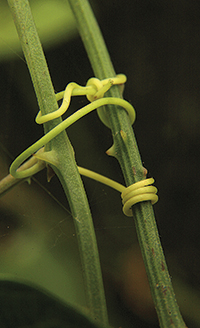
If we consider leaf-climbers separately, the idea that they may have initially been climbing plants is very appealing. The internodes of all, without exception, revolve in exactly the same way as twiners: a few can still twine well and many others do so imperfectly. Several leaf-climber genera are close to other genera which are simple twiners. We must also consider that the possession of leaves with sensitive petioles, with the consequent ability to grasp objects, would be of little use to a plant unless it was associated with revolving internodes, by which the leaves can come into contact with a support. Moreover, revolving internodes are sufficient, without any other aid, to confer the ability to climb, so it seems likely that leaf-climbers were previously twiners and were later able to grasp supports, a skill that represented an additional advantage.
For the same reason, it is likely that all tendril-bearers were twiners in their original state, that is, the descendants of plants that had the ability to climb, spirally twining around a support. The internodes of the majority of tendril-bearers revolve, and, in a few species, the flexible stem retains the ability of spirally twining around an upright stick. As tendril-bearers have undergone much more modification than leaf-climbers, it is not surprising that their supposed primordial habits or revolving and twining have been more frequently lost or modified than those of leaf-climbers.
It is possible that Darwin was familiar with the observations made by Johann Wolfgang von Goethe – since he belonged to his grandfather’s generation – on the metamorphosis of plants, where he proposed that all plant organs are modified leaves. In any case, the results of Darwin’s experiments with several species of Lathyrus are delightful: he describes the transformation of leaves into tendrils and how in that case there is an exaggerated development of the stipules as a compensatory mechanism due to their lack of leaves. These observations led him to propose that tendril-bearers, which are formed from modified leaves, were originally twiners supported by leaves. That’s why tendrils emerge as adaptive elements that, according to Darwin, show a high state of organization in climbing plants: initially, the tendrils right themselves due to the force of gravity, respond to light by bending towards it or ignoring it, whichever may be more advantageous. For several days, they revolve spontaneously with a steady motion. Then they strike some object and quickly curl around, grasping it firmly. In the course of a few hours they contract into a spire, forming an excellent spring. All movements now cease and the tissues become strong. The tendrils have done their job, and have done it admirably.
The genetic bases of plant movements
Seven generations after Darwin’s observations on the movement of climbing plants, known today as circumnutation, we are beginning to understand the molecular bases behind it. Most of the plants are able to perform an oscillating movement called circumnutation by which they can rotate around a central axis during their growth. This capability is higher in climbers and, even today, we are still discussing whether it is a nastic endogenous movement or, on the contrary, it depends on gravitropism.
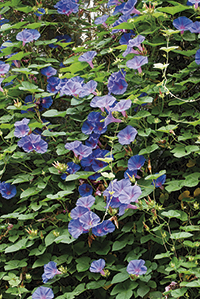
The relationship between circumnutation and gravitropism has been proposed by Kitazawa and his colleagues, based on observations of a mutant Ipomoea nil called weeping, not affected by gravity. Its stem has a phenotype that makes it turn in response to gravity, and it is also incapable of circumnutating. This hypothesis is also supported by the observations on the gravitopic mutants of Arabidopsis thaliana, whose gravity-perceiving cells or statocysts present dysfunctions. Statocysts are located in the cells contained in the centre of the columella of the root cap of the root and in the endodermal cells adjacent to the vascular tissue of the stems. These cells use dense amyloplasts called statoliths to move in response to gravity. However, Arabidopsis mutants with low starch content and therefore with defective statoliths have both their capacity of responsiveness to gravity and their capacity of circumnutation reduced.
In addition, scr (scarecrow) mutants, which lack endoderms, have a stem insensitive to gravity and have dramatically lost their ability to circumnutate. The SCR gene has been characterized at the molecular level and belongs to a gene family of transcriptional factors that are necessary for the asymmetric cell divisions required during endoderm differentiation in stems and roots to occur. As the phenotypes of the weeping Ipomoea and scarecrow Arabidopsis mutants are similar, scientists have conducted studies of functionality of the SCR gene to isolate it from Ipomoea nil (Pn SCR) and found that it is capable of complementing the mutation in the scr genetic background of Arabidopsis. This would support the idea that the SCR gene is required for the differentiation of the endodermis and the perception of gravity in Ipomoea.
The mutation of the Pn SCR gene in the weeping mutant has also been characterized. The protein that encodes the mutated gene has an insertion of an amino acid in the highly conserved motif of VHIID of this transcription factor. It has been found that the mutation is due to a defective circumnutation compared to the gravitropic response in wild Iponomea nil and in GM Arabidopsis plants expressing the mutant scr allele. Finally, it was found that other Arabidopsis mutants that, while having endodermis, show abnormal movement of its statoliths, also exhibit abnormal circumnutation movement. All these observations suggest that circumnutation oscillatory movements are coupled directly to the perception of external stimulus of gravity, at least in Pharbitis and Arabidopsis.
«For three years Darwin observed nutation movements in climbing plants, both at his hot-house at Down and in his study»
By contrast, Charles and Francis Darwin proposed that circumnutation responds to an internal stimulus and controlling system of the plant. There are other current observations, such as those made with sunflower plants aboard the Columbia space shuttle, suggesting that circumnutation can be dissociated from the perception of gravity since that movement can take place in the absence of significant gravitational accelerations, as in the case of microgravity. Sunflower plants have a great capacity of circumnutation: Brown and his team showed that 93% of sunflower seedlings can perform an oscillatory motion in microgravity conditions, but with a smaller amplitude and shorter duration than plants grown in Earth. Given the difficulty of repeating studies in microgravity conditions, today it is not possible to clarify whether the discrepancies described here have an explanation based on the plant species used in the studies or whether they have a basis associated with experimental design (i.e. instead of germination seeds, etc.).
In summary, three models are postulated to account for the circumnutation of plants: the first is a model that would base the control of this movement in an internal oscillator connected to circadian rhythm and the second is a model dependent on gravity force, the so-called Cholodny-Went theory. This theory explains the asymmetries in the growth rate of an organ or tissue by asymmetries in auxin concentrations that occur before and during asymmetric growth. Thus, the oscillations of circumnutation could be interpreted as a continuum of the plant’s compensatory responses to changes in the orientation of the gravity-sensing system with respect to the gravity force vector.
Finally, some scientists defend a third model that integrates the former two, which would be based on two oscillators. According to this model, circumnutation is a gravitropic reaction which acts as an oscillator that powers itself externally with another internal oscillator that provides a rhythmic signal.



